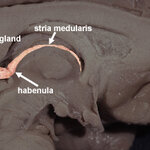Science category landing
Social Sciences

Machado Joseph disease (MJD) is a neurodegenerative disorder associated with deposits of an aberrant form of the protein ataxin-3 in the brain. The disease is also fatal and the most common hereditary motor neurodegenerative disease in many countries. Despite this, not much is known about MJD including the neurological basis of some of its symptoms, which cannot be linked to the brain damage found in patients.
But now, researchers in Portugal and France using a new animal model of the disease were able to show, for the first time, that MJD also affects the striatum, a brain area associated…

Humans communicate with machines every day and work is always being done to make interfaces more intuitive, but purely in regard to mechanical aspects.
There's no question that the machines are in control - you do it in a way they understand or you are stuck. Moore's Law has been in effect for processors and raw horsepower but interface advancements and understanding are still trapped in the 1960s.
The Humaine project wants to change that by bringing together specialists and scholars from very different disciplines to create the building blocks and tools needed to give machines so-called ‘…

New research shows that even affluent college students who don't need resources will still attempt to trade sexual currency for provisions, said Daniel Kruger, research scientist at the University of Michigan School of Public Health.
The exchange of resources for sex, referred to by scientists as 'nuptial gifts', has occurred throughout history in many species, including humans, Kruger said. The male of the species offers protection and resources to the female and offspring in exchange for reproductive rights.
Female penguins mate with males who bring them pebbles to build egg nests.…

Dog owners, who have noticed that their four-legged friend seem equally delighted to see them after five minutes away as five hours, may wonder if animals can tell when time passes.
Newly published research from The University of Western Ontario in London, Canada may bring us closer to answering that very question.
William Roberts and his colleagues in Western’s Psychology Department found that rats are able to keep track of how much time has passed since they discovered a piece of cheese, be it a little or a lot, but they don’t actually form memories of when the discovery occurred. That is…

A new study by researchers at UC Davis shows how our very short-term "working memory," which allows the brain to stitch together sensory information, operates. The system retains a limited number of high-resolution images for a few seconds, rather than a wider range of fuzzier impressions.
Humans rarely move their eyes smoothly. As our eyes flit from object to object, the visual system briefly shuts off to cut down visual "noise," said Steven J. Luck, professor of psychology at the UC Davis Center for Mind and Brain. So the brain gets a series of snapshots of about a quarter-second, separated…

It's well known that the left and right sides of the brain differ in many animal species and this is thought to influence cognitive performance and social behavior. For instance, in humans, the left half of the brain is concerned with language processing whereas the right side is better at comprehending musical melody.
Researchers from University College London have pinpointed for the first time the left/right differences in how brains are wired at the level of individual cells. To do this, a research team led by Stephen Wilson looked at left and right-sided neurons (nerve cells) in a part…

Teenagers insist parents can't understand them and parents think teens' brains are different than smaller children or adults. A new article by Jay N. Giedd, MD, of the National Institute of Mental Health (NIMH) says that second part may actually be true.
Giedd's article reviewed the results from the NIMH Longitudinal Brain Imaging Project, which indicated that gray matter increases in volume until approximately the early teens and then decreases until old age.
The NIMH Longitudinal Brain Imaging Project began in 1989. Participants visit the NIMH at approximately two-year intervals for brain…

A predisposition for obesity might be wired into the brain from the start, suggests a new study of rats in Cell Metabolism.
Rats selectively bred to be prone to obesity show abnormalities in a part of the brain critical for appetite control, the researchers found. Specifically, the researchers show that the obese rats harbor defects in neurons of the arcuate nucleus (ARH) of the hypothalamus, which leaves their brains less responsive to the hunger-suppressing hormone leptin.
“The neurodevelopmental differences in these animals can be seen as early as the first week,” said Sebastien Bouret of…

Pioneering research at the University of Sunderland has shown that regular exposure to safe low level infra-red light can improve learning performance and kick-start the cognitive function of the brain.
The results are a scientific breakthrough as to date medical treatments for dementia can only slow down brain deterioration and now human trials are to start to see if the treatment could provide a cure to illnesses like Alzheimers.
Independent research carried out at Sunderland has demonstrated that low power infra-red (1072nm) can improve the learning performance. The low levels of infra-…

BBSRC scientists have found that the part of the brain that deals with sound, the auditory cortex, is adapted in each individual and tuned to the world around us. We learn throughout our lives how to localize and identify different sounds. It means that if you could hear the world through someone else's ears it would sound very different to what you are used to.
Recognising people, objects or animals by the sound they make is an important survival skill and something most of us take for granted. But very similar objects can physically make very dissimilar sounds and we are able to pick up…